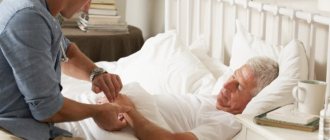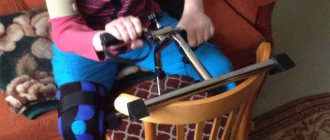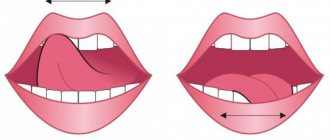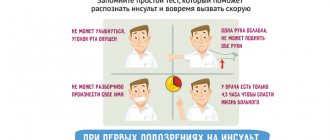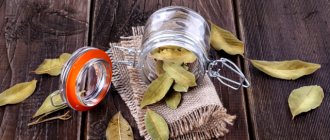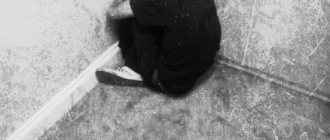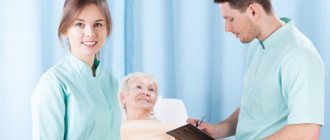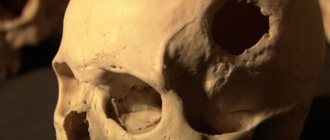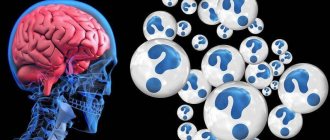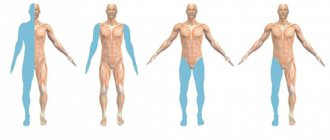The most common consequences of any stroke pathology are movement disorders (paralysis) on the right or, conversely, on the left side of the body.
With this pathology, only the side of the human body that is controlled by the cerebral hemisphere damaged after a stroke is always affected.
Many people wonder what the chances of survival are for patients with one or another type of stroke pathology or which type of brain stroke has a more positive prognosis. Let's try to figure it out step by step.
Functions of the cerebral hemispheres
As we all know from a school biology course, the responsibility of each hemisphere (be it the left or right hemisphere) of the brain extends strictly to opposite parts of the body.
This means that in cases where a cerebral catastrophe develops with damage to the left side of the brain, the entire right side of the body may be paralyzed (depending on the extent of the focus of tissue necrosis), although the left side will function as before.
If a patient has left-sided paralysis after a stroke, pathologists can conclude that this victim’s brain is affected not on the left, but on the right side. In addition, since the responsibility of our left hemisphere extends to such functions as:
- Patients' logical thinking and language abilities.
- Analytical thinking, when the responsibility of this hemisphere includes logic and analysis.
- Literal understanding and awareness of speech.
- Sequential information processing.
- Our mathematical abilities, in cases where apoplexy of the left side of the brain develops in a right-handed patient, these very functional abilities will be impaired.
Among doctors, it is generally accepted that paralysis of the right side of the body is recovered much better and faster, and a left-sided stroke itself may have a more favorable prognosis when compared with stroke pathology in which paralysis of the left side of the body is observed.
Doctors also attribute this fact to the fact that, as a rule, a cerebral stroke, localized in the left lobe of the brain, can be recognized somewhat faster by outsiders, who quickly notice specific speech disorders of victims after a brain stroke.
Symptoms of pathology
In the presence of a left-sided stroke, it is important to notice the first manifestations. The following signs can be identified:
- Problems with the functionality of facial muscles. Usually the left corner of the mouth and eyes droop.
- Partial paralysis of the limbs. The functioning of internal organs located on the left side of the body is also disrupted.
Since it can be difficult to determine the presence of a stroke (the consequences of which are reflected on the left side of the body), and emergency care is provided late, a different clinical picture develops. Symptoms become more intense. The consequence of hemorrhage is paralysis of the eye and hearing problems. There is a disturbance in the perception of the left side of the head.
The patient also has other signs:
- Disorientation in space and time.
- Problems with memory, vision (one pupil will be larger than the other), touch and hearing.
- Behavioral changes: increased aggression, which is difficult to explain, inappropriate reactions to events.
- Violation of color perception.
Both ischemic and hemorrhagic strokes of both the left and right sides are characterized by impaired consciousness, vomiting, dizziness, and pain in the head. The victim has trouble breathing. Extensive hemorrhagic stroke has a high intensity of cerebral symptoms. The predominant signs are neurological, which depend on where the artery is affected.
It should be noted that in left-handed people with damage to the head on the right, a violation of spatial orientation may not occur.
Ischemic stroke of the left hemisphere is characterized by the following symptoms:
- Difficulty in performing simple household functions and self-care operations (a person can be paralyzed).
- Impaired functioning of the right half of the body.
- Changes in coordination.
- Pain on the right side of the body.
- Speech impairment (written and oral).
A wonderful specialist neurologist Mikhail Moiseevich Shperling will talk about the symptoms of the pathology:
The consequences of a stroke (in which the left side of the body suffers and the person is paralyzed) are very severe and difficult to eliminate. The fact is that after a rupture of an artery in a patient, a brain hematoma forms, which puts a lot of pressure on the tissue. At this time, cell death occurs, so the sooner help is provided, the fewer consequences will appear. However, a person can be paralyzed even if the therapy was carried out correctly. It all depends on where the vascular pool is damaged.
Why can paralysis of the left side occur after an attack?
Any paralysis after a violation of the integrity or blockage of a cerebral vessel occurs because the affected area of the brain ceases to receive nutrients, oxygen and vitamins. On the contrary, toxins accumulate in it, which leads to its damage.
Since each part of the brain is responsible for performing certain actions, the functioning of internal organs and systems, with significant damage these functions cease to be performed.
Paralysis of the left side of the body occurs when damage to the right hemisphere of the brain is extensive and affects a significant area of the organ. In cases where small areas are damaged, only an arm or leg can be paralyzed.
If we talk about the causes of stroke, there are many of them, and each of them can provoke a cerebral hemorrhage:
- If a person has previously suffered from viral infectious diseases that affected or negatively affected the state of the central nervous system.
- If you receive a traumatic brain injury at home, in an accident or during sports.
- Autoimmune diseases leading to various malfunctions of the body.
- An unbalanced diet, an abundance of fatty and unhealthy foods in the diet, which provokes the appearance of cholesterol plaques on the walls of blood vessels.
- Diseases of the cardiovascular system.
- Brain tumors of various origins.
- Poisoning of the body with toxic substances.
- Constant stressful situations, increased nervous excitability.
- Tendency to high blood pressure.
- Having bad habits such as drug addiction, alcoholism and smoking.
- Obesity, tendency to gain excess weight.
- Diabetes mellitus at any stage.
- Patients who have already been found to have elevated cholesterol levels in their blood.
People who have at least one of the listed negative factors are more susceptible to cerebral hemorrhage of any kind.
Features of pathology treatment
Since the patient may be paralyzed, therapy should be carried out immediately. To begin, the victim needs to be laid on a horizontal surface with the head being higher than the level of the body (it is advisable to turn it to one side, as the person may vomit). At this time, you should urgently call an ambulance. Before the doctors arrive, the patient should not be given any medications, so as not to reduce the symptoms.
According to ICD 10, the pathology has its own code - I63. In case of a stroke accompanied by damage to the left side of the body, treatment is carried out only in a hospital, under the constant supervision of doctors. The severity of the pathology is one of the determining factors influencing the choice of treatment regimen. To eliminate the acute period and further maintain the normal state of the body, the following drugs are used:
- Antithrombolytics: Aspirin. They prevent the formation of blood clots and reduce blood clotting.
- Blood thinners that improve fluidity: Warfarin, Heparin.
- Thrombolytic agents that help break up a blood clot: Actilyse and others.
- Neuroprotectors: Diacarb, Piracetam, Ceraxon, Semax. They protect brain tissue and prevent repeated hemorrhage.
- Vitamins, antioxidants: Mexidol.
- Combined products: Phezam, Thiocetam.
- If a person has a fever, he is prescribed antipyretic drugs.
Recovery after a stroke is also not complete without medications. Here you will need: neurotrophics, drugs with erythrocyte action, vasoactive and antihypertensive drugs. Sedatives and angioprotectors are also needed.
To reduce vascular spasm, Glycine is prescribed. All medications are used strictly under the supervision of the attending neurologist. The drugs are designed not only to eliminate the consequences of a left hemisphere stroke, but also to prevent its recurrence, as well as improve brain activity.
Causes of paralysis
If a stroke paralyzes the left side, it is important for doctors to determine what caused it. For this, comprehensive diagnostics are carried out. Determining the culprit of the pathology helps to select the most effective treatment method and course of rehabilitation for the patient.
The reasons for the development of a stroke, as a result of which the left side of the body may be lost, may be the following phenomena:
- Viral infectious diseases that affect the central nervous system.
- Brain injuries.
- Failure of metabolic processes in the body.
- Poor nutrition.
- Vascular diseases.
- Tumors in the brain.
- Frequent stress and depression.
- Poisoning of the body.
People most at risk for stroke and paralysis are at risk. These include patients:
- Alcohol and smoking abusers.
- Having problems with blood pressure.
- Suffering from diabetes.
- Those who are overweight.
- Having high cholesterol levels.
People at risk should be screened regularly to prevent the development of stroke.
General rules for patient recovery and care
In order to prevent a stroke affecting the left hemisphere of the brain from developing, it is necessary to prevent those factors that can provoke it: monitor the condition of blood vessels, eat right, give up bad habits. If the patient had a history of head trauma, then treatment for a concussion had to be carried out.
The health of blood vessels is in your hands - read how to clean the blood vessels of the brain using folk remedies.
If an attack does occur, and the left side is paralyzed after a stroke, the patient requires thorough and long-term rehabilitation. It can take months or even years to even partially restore the functionality of the affected areas of the brain. It is difficult to make an accurate forecast.
So, the rehabilitation process has its own characteristics:
- It is necessary to restore not only a person’s physical functions, but also his psychological state. Normalization of mental processes is required.
- A patient who has suffered a stroke and suffered paralysis is in a supine position almost all the time. Since his left eye is affected, his bed should be positioned so that he can cover the room with his right.
- It is necessary to talk to the patient by moving to the right so that he is able to assess the situation and the interlocutor.
- All things that the patient must use must also be placed on the right side.
- Recovery should be carried out using speech functions. That is, the victim must try to characterize those things and objects that fall into his field of vision. Due to the fact that speech is practically not impaired, the patient has the opportunity to establish a balance in the functionality of both hemispheres of the brain.
In the video, neurologists from the Center for Rehabilitation of the Administration of the President of the Russian Federation will talk about an integrated approach to the recovery of patients who have suffered various strokes:
- It is necessary to engage in breathing exercises with the patient, which will prevent the development of congestive processes in the lungs, as a result of which pneumonia occurs.
- After discharge at home, the sick person continues to perform special exercises that were prescribed in the hospital. This will help restore motor activity.
- Massage is considered an effective means of rehabilitation.
- Exercises must be performed every 3-4 hours. This will make it possible to quickly restore sensitivity to the left side of the body. At first, gymnastics is done in a horizontal position, and as the patient’s condition improves, he performs all actions while sitting and standing. To begin with, the patient needs outside help. He is also recommended to use special devices: belts, stands, handrails.
In addition to proper rehabilitation, paralysis of the left side requires qualified actions by medical staff and relatives of the victim in terms of caring for him. It provides:
- Constantly changing the position of the patient so that he does not develop bedsores, which are very difficult to cure. It is also important to prevent the development of pneumonia. The patient must be turned and rubbed every 2 hours.
- A person's bed should be clean, dry and level.
- Limbs should not hang over the bed, as this will lead to joint deformation. If an arm or leg still falls, then it is better to place a chair or stool next to the bed.
Passive exercises for paralyzed limbs: a - movements in the shoulder joint; b, c, d — movements in the elbow joint; d, f - movements in the hip and knee joints.
- To restore the functionality of the limb, it is necessary to constantly develop it. For this purpose, certain exercises are used (passive gymnastics, when the rehabilitation therapist bends and extends the paralyzed arm and leg). Massage is helpful.
- If the patient is completely paralyzed, then cushions should be placed under the armpits. This will make it possible to position the shoulder joints correctly and prevent their deformation.
In general, the rehabilitation process also includes physiotherapeutic procedures and sessions with a speech therapist. Special correctional programs to restore the patient’s normal psychological state would be useful. A person must be conditioned to the fact that in order to recover he will have to work hard and for a long time. A positive mental attitude will help you recover faster.
A teacher at the Institute of Rehabilitation Medicine, Alexander Davidovich Bonduryansky, will show a complex of exercise therapy at the stages of rehabilitation after a stroke:
During rehabilitation, the patient must follow a daily routine and eat properly. He is prohibited from drinking alcohol and smoking. Light sports, even after partial recovery, will help consolidate the positive result.
To speed up the rehabilitation process, the patient should try to independently perform some basic household tasks.
Treating stroke at home with folk remedies
It is appropriate to talk about diet here. During this period of time it must be special. It is best to balance your diet with dairy products and plant foods. It is optimal to offer the patient berries, fruits, cottage cheese, kefir, and cereal porridge.
Meat and fish are excluded until the general condition improves. At this time, it is good to prevent vitamin deficiency. Decoctions of rose hips, hawthorn, and currant compote are perfect for this. Vitamin C can improve immunity, which will allow the body to recover faster.
A strict diet for people with paralysis is mandatory! Do not forget that there should be a positive atmosphere around the patient. He himself must be configured for rapid recovery. You should not cry near a paralyzed person and feel sorry for him; you should set the person up only for the best.
To restore muscles faster, you need to do restorative exercises daily. A suitable set of exercises must be selected by the attending physician. For three weeks after a stroke, it is necessary to rub the patient with burning ointments to restore blood flow.
Herbs will help speed up recovery. In folk medicine there are many ways to make recovery go much faster.
- Maryin root. The dried herb is poured with boiling water and left for 5 hours. To put your body in order, you need to drink 2 tablespoons a day.
- Mumiyo. Dilute the drug in water. You need to drink this drink once a day, 1 glass.
- Bay leaf. An infusion of bay leaves will quickly restore the body after a stroke. An infusion is made from ground laurel leaves and sunflower oil is added. This infusion should be lubricated on the affected areas of the body. Can be used as a massage oil. You need to infuse this remedy for a week.
- Lemon and garlic. Take 100 g of lemon and 100 g of garlic. Mix everything. Leave for about 7 days. This mixture should be given to the patient twice a day. It is better to take after meals.
All these remedies will help to cope perfectly with the patient’s difficult condition and will quickly put him on his feet.
Consequences
Many readers are interested in how long they live after a stroke on the left side. It all depends on the severity of the disease, as well as how extensive the area that is affected is. About 30% of patients die in the first year after a stroke. However, if the recovery period is successful, then in the absence of relapse a person can live for a long time. If he falls into a coma, then it is important to get him out of it as quickly as possible.
If the comatose state persists for more than a week, the chances of survival drop sharply.
The consequences of a stroke on the left side can be different. This is mainly paralysis, loss of orientation, changes in behavior and the functionality of mental processes. Most violations remain with the victim for life. Therefore, it is important to undergo the most effective rehabilitation during the first year after a stroke.
Symptoms of paralysis
After the attack occurs, the patient experiences pronounced symptoms indicating extensive hemorrhage and brain damage. There are 3 types of such manifestations. The victim completely lacks voluntary motor activity. This occurs due to the lack of impulses in the nervous system.
At this stage, it is important to determine what kind of stroke - ischemic or hemorrhagic - the patient suffered. This will determine subsequent treatment tactics and rehabilitation.
The skin loses sensitivity, the person does not feel pain, heat, cold, or touch. Lesions can be both significant, when the deep layers of the skin are affected, and minor, when sensitivity is absent only on the surface of the skin.
Vision problems may occur when the patient loses half of his field of vision, often on both sides. Such disorders do not necessarily lead to blindness; as a rule, a person practically does not notice them. Deformation of the facial muscles is often observed when significant asymmetry of one of the sides occurs.
All of the above manifestations suggest a cerebral stroke. In this case, the patient must be taken to the hospital as soon as possible to undergo examination and prescribe adequate treatment.
Bedsores during paralysis - what is it and how to fight it?
Bedsores are injuries to the skin and soft tissue that occur as a result of poor circulation in a specific area of the body. They are formed where the body comes into contact with a hard surface.
ATTENTION!!! This state must not be started under any circumstances! It can develop into gangrene when tissues left without nutrition begin to die. As a result, infection and amputation of the upper or lower limbs is possible.
In patients who are malnourished or have severe heart disease, bedsores develop more quickly. The protruding parts of the body are most susceptible to damage. In rare cases, the occipital region or breast folds in women are affected.
To prevent the development of bedsores, it is necessary to carefully monitor the patient. Every 2 hours it is recommended to change the position of his body. To fix the required position, pillows and other similar soft objects are used. It is also important to ensure that the body does not come into contact with the hard surface of the bed.
Be sure to keep your skin hydrated. To do this, you can use various means, for example, sprays, creams. It is necessary to wipe the skin 2 times a day. You also need to massage paralyzed tissues.
The ideal option would be to purchase a special mattress that prevents bedsores. All of the above measures will help avoid adverse consequences that may arise.

